Musings
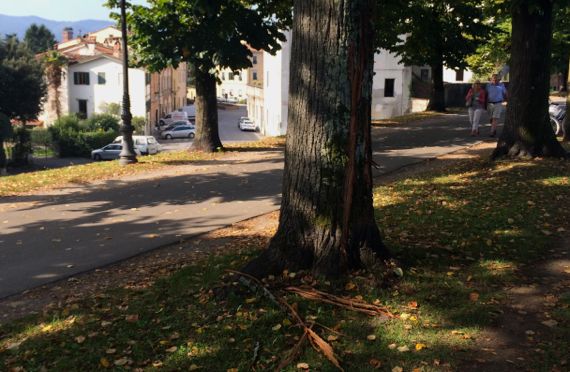
Lightning-struck tree atop Lucca’s fortification-wall. Trees line the walkway, and we enjoyed their shade very much.
Back up on the city wall to enjoy our last hours in Lucca. Loving this town. We see locals going about their business, women wheeling shopping carts, moms and kids, businessmen in sharply pressed suits, family groups moseying about…. There are tourists, of course, but except for certain times and places, they navigate amidst daily life.
And Lucca is Puccini-town! For you opera-lovers….

Several places along the wall, where repeated footsteps killed the grass, we could see a good density of broken pottery and building material fragments. I suspect the upper layer is recent re-sculpting, but I cannot tell where they got the fill to even up the wall-top. Still, my sherd-eyes spotted plenty; I left all in the dust….

Three train rides, the longest in first class (!!! only one euro more!!!), and we have relocated to the Cinque Terre (sometimes Cinqueterre), staying in Vernazza, at our niece’s recommendation. We strolled up along the footpath that leads to the next town north, but only a bit, to catch the fading light. (This pano distorts, but I rather like it.) In the old days, the only way to get between the five coastal towns was via boat or footpath. Now there’s the train, which almost entirely travels in tunnels; Italian engineers love tunnels.
Posted at 1:47 PM |
Comments Off on Making tracks

In the heat of the midday (as it turned out), we ventured forth via bus to Pisa, once again joining crowds of day-trippers self-funneling into a very few locations. The architectural complex that includes the famous un-plumb bell-tower is in a giant grassy area, with tremendously outsized buildings. The complex is unlike any other church complex we’ve seen for its size and the fact that it is not integrated into the cities’ active streets, shops, institutional buildings, and domiciles. Fortunately, the scale of the buildings and the campo partially temper the funneling problem.

Tourist-behaviors rarely offer surprises. We watched people doing the “pushing upright” photos. Often the photographer and the subject had repeated back-and-forths to get the desired effect captured. We just photoed unfolding events, rather than doing it ourselves.

To my eye, the cathedral next to the Leaning Tower also evinces evidence of foundation unevenness and sinking. Look at those last four arches (left) and the lines of the sections of the building. There’s some distortion by the camera, but there’re non-parallel lines in the building, too.

Back “home” in Lucca, we strolled the defensive wall that circles the old-town to catch the sunset. I did not expect the high craggy mountains that populate the skyline in this direction, but they are eye-catching.
Posted at 10:22 PM |
2 Comments »
Transition days have their own excitement. We partly left our “old” B&B, packing up but leaving our luggage and heading into town to see a Picasso exhibit we’d skipped, but were interested in, in part as an antidote to gorging on the Renaissance for the last few days. One room was all Picasso sketches prior to Guernica. The rest had one or two Picassos, and many works by contemporaries. Which is okay, but Picasso was heavily billed and not so strongly represented. We enjoyed it plenty as a palate-cleanser (JCB trademark phrase).
Florence was over-run (oops) with people in-town from the whole surrounding area for a run-walk event. Thousands, I’d say. They filled the streets for hours, and several bridges were pedestrian-only that usually have vehicles, so I’m sure plenty of people were happy to attend/participate, and plenty were a bit aggrieved. We enjoyed the hustle-bustle, and felt sure that some of the matrons were in an unusual mode, wearing t-shirts (that had the sponsor name: Ferragamo).
All too soon, we gathered up our luggage, said goodbye to our lovely hostess, E, and headed to the train station. Oh my. We hadn’t gotten our tix online, and that turned out to be the wrong move, or at least to make it more complicated. The ticket offices had a line you wouldn’t believe. At least they had a number system, where you could take a number and wait for it to come through the rotation, although JCB said they were hours from getting to our number. Meantime, he finally got the electronic ticket machine to take one of our credit cards (not the usual one—typically a problem with USA credit cards—people can make them work, but the machines can’t deal with them), and we had our pass to ride!
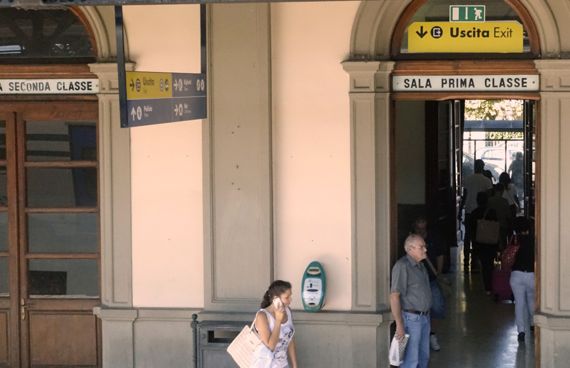
Our train had double-decker seating, so of course we picked “high” seats. The train was packed with regulars, tourists, and the runners returning to the suburbs. Loved this view of an “old” station, with separate waiting areas for first- and second-class travelers. They still have the classes (at least on some trains), but other than on the train, no differences in the stations…
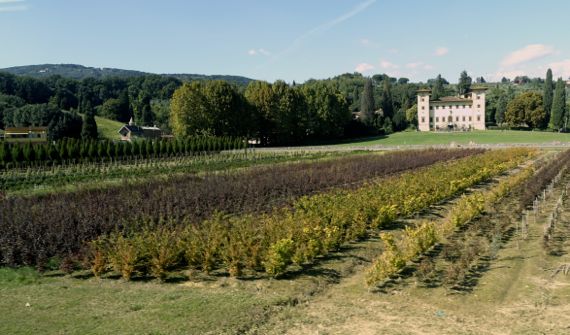
Of course I was watching the landscape as we moved westward. I saw some fields and small gardens, plenty of apartment buildings in the towns and on the edges of them, a few abandoned industrial buildings, some new commercial architecture, roads, the expected hodgepodge. To my eye, however, there were disproportionate numbers of landscaping plant yards, although this is the only one I noticed on the grounds of a villa; everyone with acreage has to monetize it somehow—or else subsidize it. I was still amazed that most of the ridges were forested, although sometimes I could see the rows of trees, so they were planted, probably in a post-WWII reforestation program.
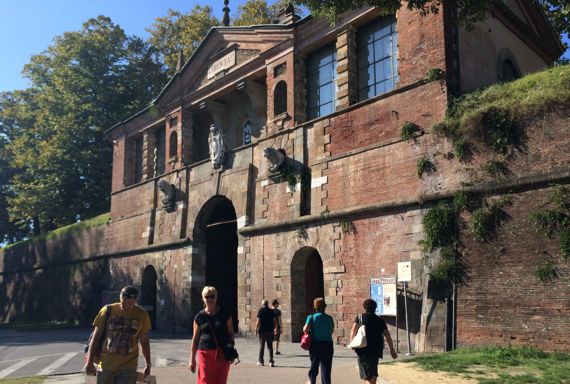
We disembarked at Lucca, our next stop, and the walls of the city were right in front of us as we left the station. While the city walls are what you notice, the city-center also contains the grid of the ancient Roman settlement the pre-dated them. The walls were built between 1500 and 1650, and include eleven bastions and twelve connecting curtains. We had to dodge a block to the west to enter the city through a gate thoughtfully and emotionally labeled Libertas.
Our new B&B is our splurge of the trip, and they must think so too—we were greeted with a gift half-bottle of prosecco, and happy are we now that it is empty!
Posted at 12:49 PM |
Comments Off on Libertas
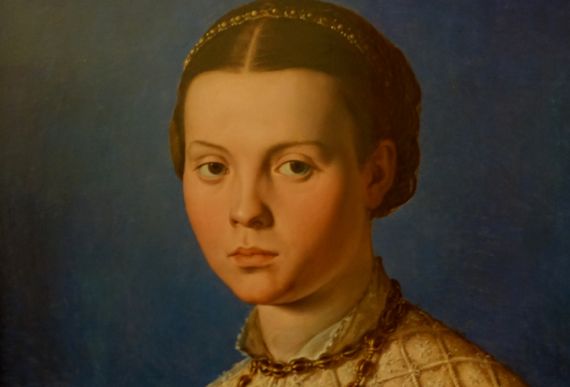
Let’s go for some image-bits, all from paintings. This young woman, hmm, relying on memory here (it’s been 6 hours and 6K paintings/labels in between now and when I read the placard), she was probably an orphan, although experts don’t know for sure who she is. Can’t really account for her expression…maybe “I got out of mass to sit with this…creep???” (Sorry, you’ll have to guess the date….)
These two are details from a very small part of a painting, meant to set the stage, fill in, and be background. To me, they give clues about the countryside at that time.
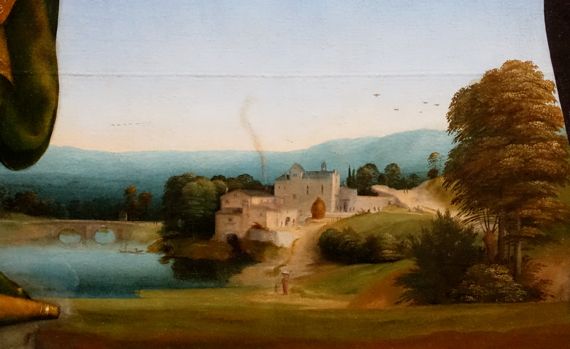
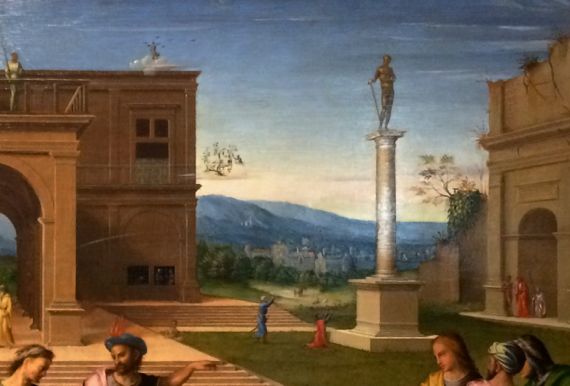
The first one is by Fra’ Bartolomeo and dates to 1509. The second is by Francesco Granacci, and dates to about 1515.
First, I see there’s lots of forested area and they both look Tuscan. Second, the buildings are large and scattered. This latter is generally consistent with the villa pattern. They both have small airborne bird-flocks (which suggests more birds than I’ve noticed today, or merely an impulse to fill “empty” spaces a bit). Love the bridge and smoke-whisp in the first one. Charmed by the vegetation indicating the ruined nature of the architecture in the second.
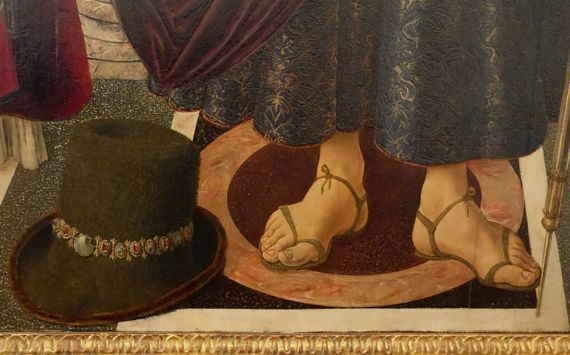
I took lots of foot-photos today (well, a few anyway), and I’m only giving you a ration of one. These are simpler sandals than most, but that is one fancy hat. I believe the scallop shell indicates the wearer is going on or has been on a pilgrimage to Santiago de Compostela (that being a shrine of St. James, and the shell indicating him). Also, the hat shape may indicate the pilgrimage, too. This is consistent with the walking stick(?). This is by the Pollaiolo brothers and dates to about 1467.
Posted at 3:56 PM |
Comments Off on Painted eye candy
We did two very different things today, morning and afternoon. Morning was Florence’s archaeological museum (local, old stuff, and Egyptian and Greek stuff, plus a fantastic exhibit of OLD Sardinian artifacts, with some interpretation). Afternoon was a bus trip to Siena to stroll the old town.
Here’re a couple of Etruscan goodies. The ceramic dates to 575–550 BC. Loving the creatures and the shapes filling in the band they’re in.


This fan of bronze is a fancy version of an item that was likely in daily use, but made of mundane materials—probably plant leaves. They both came from burial tombs, the ceramic from Vulci and the fan from Populonia.
In Siena, we strolled with the crowds to the Cathedral. It’s huge and on a hilltop, with a piazza around it that allows photographers to get back almost far enough to capture the entire façade.
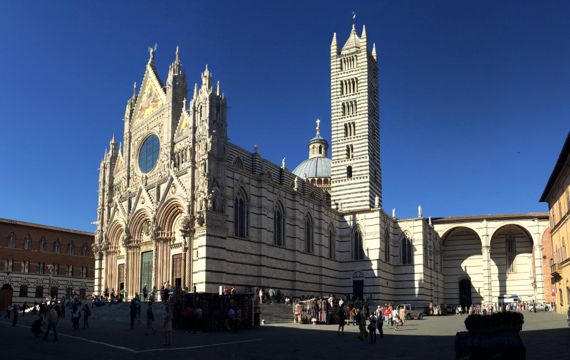

I used pano to get the width of the façade, dome (peeking), bell-tower, and a transept that extends to the right in the photo and never was finished. Apparently, the building was in use by around 1200, with the façade still under construction, and the fancy stuff in the second shot is generally dated to 1360–70. You can see the light was perfect for our brief sojourn.
After the duomo, I was on an “up” search. I think of churches as being on the high point, and this one is on a local high point, but not far away is a higher knob, and I was curious. So, we (Patient Guru and I) wended our way through narrow Medieval streets to find a strange spot by another small, modest church (closed for renovations, with workman shoveling broken chunks of cement into a wheelbarrow in the doorway as we passed), that was as high as we could go. So there was a church on the highest point here, too, and a little space we could see through an iron fence and across an angular array of rooftops to spot the top of the duomo façade and bell-tower just barely visible. [There’s another famous church in Siena, the basilica; we skipped it. Don’t get me started on St. Catherine’s partial body parts on display here….]
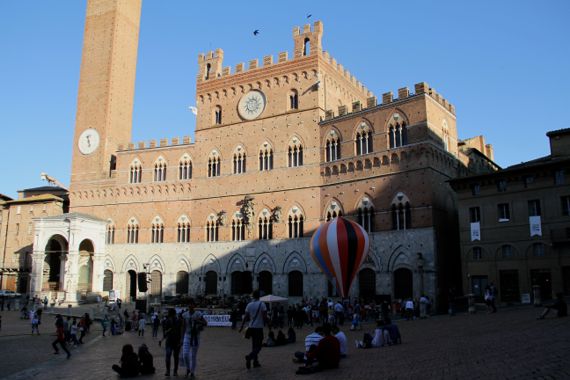
We dropped down from the high-point, empty of tourists, to rejoin the masses in the large, fan-shaped, Piazza del Campo. We ate food we’d snagged at a nearby shop, and watched/listened to a band sound-check we assumed for a concert this evening. People were flocking in, and the sound-levels were…substantial. I tried to decide if the drummer was playing with the echoes in his tempo when it was his turn. Off to the right, someone was inflating a small balloon, and one of the ubiquitous pigeons dove into this shot. That’s another bell-tower I cut the top off of…. Anyway, this was not a Roman forum or amphitheater, we are told, but a Medieval market area that drains even today into a special drain at the piazza’s low point.
Loved the archaeological museum; loved Siena. A fine day all around!
Posted at 3:40 PM |
Comments Off on Split tourist-personality
We made the decision to get the pricey one-size-fits-all-and-we-mean-all card that includes entry fees for just about every venue, plus city busses, and free wifi across the city, plus lets you cut in line. Not really, but you get to go ahead of most ticket-holders.
It’s good for museum/church/etc. entries for 72 hrs from when you first use it, so you can stretch it to four days if you make your first entry late enough in the day to make your last entry early on the last day. Only one entry per venue, though….
Great plan! Now, to put it in motion!
Trekked up to the botanical garden, apparently the first modern botanical garden ever (a Renaissance invention? Live and learn). Closed. The hail storm a week ago tomorrow, which produced enough hail to cover the streets and make them white, and was accompanied by miserable winds, brought down limbs and trees, so, safety first.

Next stop: Museo di San Marco. Turns out it is centered on a courtyard that also got damaged by the hail-storm: chiuso, again.
Well, let’s pick a museum that’s all indoors, and nearby: the archaeology museum. Ah, staff meeting today (of all things!), so closed for three hours starting at 11:45, about an hour from when we arrived. Not a long enough window for this Inquisitive. Another bust, since we have only one entry on our card.

Okay, we gave in. Let’s wait in line at the Accademia and go see Michelangelo’s David, we decided—along with two other lines of people; ours moved fastest because of the magic card, but we still waited in the street for 20 minutes. Woman behind us was a French teacher from Peru, so we talked in Spanish, which kept me distracted from the wait. Major kudos to the Guru, because line-standing is NOT his thing (can’t blame him).
Other than David, we liked the strange side exhibit of musical instruments, including early pianofortes, hurdy-gurdies, and a Stradivarius violin.
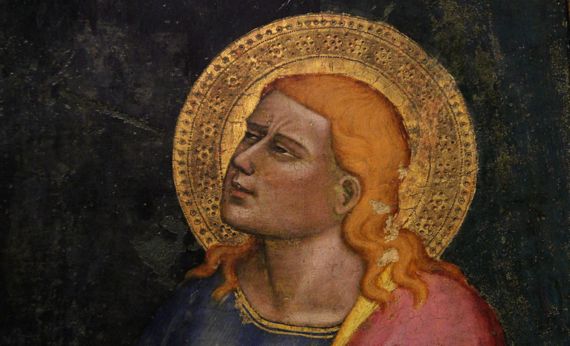
Also learned about how gold-leaf was added to altar-pieces and the like, plus more about how they were painted (DVD kept freezing, rather comically).
Escaped to the street and made a hunger-fueled beeline for the BRB chow stop, where paninis are 5€, with 2€ more if you want wine. Yummy paninis, skipped the wine, huge line here, too. Thanks for the recommendation!

Drifted a bit farther south and entered the Galileo museum. (That’s a statue of him, frowny-forehead guy number three in this blog entry.) Devices galore. Shiny bronze shapes with calibrations and loopy inscriptions.

This is a 1625 theodolite. I’ve used a theodolite, two different kinds; didn’t look like this! Principle of operation looks the same, though. Safe assumption, anyway.
Rather pooped; contemplating evening plans. Wondering if we’ll ever find/be able to connect to that free city wifi…. Over and out.
Posted at 1:12 PM |
2 Comments »
The title’s a bit of a reach…. Still, our main agenda today was to transition from Tiber-City to Arno-City.
The historical focus of the cities is so different: ancient Rome vs the Renaissance…from establishment of a state/civilization to a being the seat and incubator of a shift in cultural tastes and values.
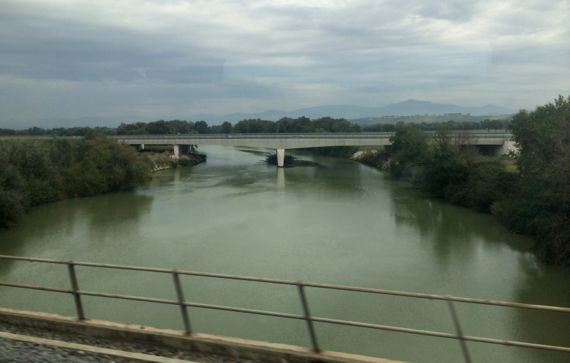
Tiber, view east, north of Rome, from the fast train at 250 km/hr.

Arno, view west, just after sunset.
Posted at 10:22 PM |
Comments Off on Tale of Two Rivers
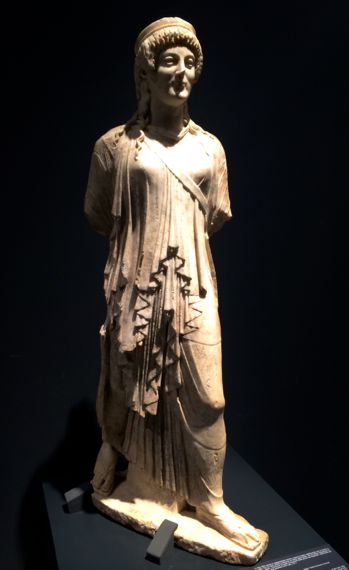
We did the museum thing today. One museum: the National Museum, or the Museo Nazionale Romano di Palazzo Massimo (it has three additional locations).
The collections shown are, as far as I could tell, from Rome and Ostia, Rome’s port town. The two communities acted economically as a unit, more or less, one with the port and one with most of the population, and the political/economic center. The museum’s displays are terrific, and there’s an English translation on most of the signs that’s pretty good.
This is a statue of the Greek goddess Artemis, considered equivalent of the Roman’s Diana. That’s her arrow-sling strap across her shoulder, and when complete, she would have held a bow and arrows in her right hand. I love the flow of her garment. The statue dates to the early 1st C AD, and is in the Greek style.

Viewing these exhibits brought our focus to the specific, and allowed insights into how people lived in and used spaces we’ve only seen as walls so far. I especially loved the frescoes that conservators managed to remove from several villae, including the Villa Farnesina ruins on the bank of the Tiber on the west bank just upstream of today’s Ponte Sisto. Doesn’t this pair get you in the partying mood?
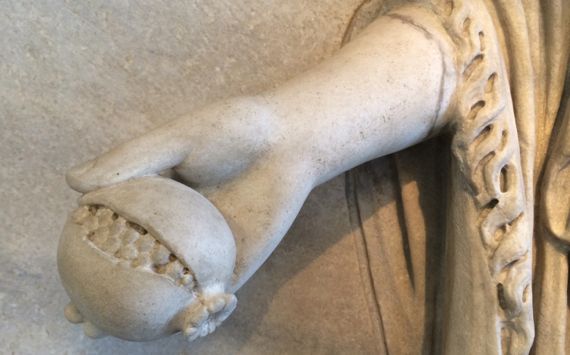

These are details from two bas-relief figures on large panels that were part of the Temple of Hadrian in the Campus Martius (more detail in Italian). I love that you can tell that one figure is holding a pomegranate, and the other green onions. The temple survives (at least above ground and visible from the street) as a line of columns and the wall close behind it, incorporated into the 17th–C papal palace that is now the stock exchange. The sign said they date to AD 145.
Still the focus of the exhibits is on the unusual, the best-preserved, and the ways of the wealthy/elites. I kept wondering about the living situation of most of the populace, etc. Loved the coins in the basement, as the text tied them to historical changes—e.g., when the popes began minting money, which happened under Eugenius IV, who reigned from 1431–47.
Posted at 1:25 PM |
Comments Off on Amused at a museum
Over 17K steps today (thank you, Fitbit; no Apple Watch yet!), from an expedition to the Caelian Hill. That’s immediately south-southeast of the Colosseum. Look for the cluster of gladiators with Aussie accents checking their smartphones, and head uphill.
We found a quiet park (Celimontana) and a closed park (Celio). I was bummed because the one I really wanted to see was the Celio. Still, in the Celimontana, it was shady and we got to listen to flocks of noisy parrots in the treetops. Yes, in Rome.
We checked out several indoor locations, one museum and two churches. Well, actually the museum included church ruins, so maybe two-and-a-half churches. Rather unlike us….
The churches constitute a study in contrasts. Here are the two active churches.
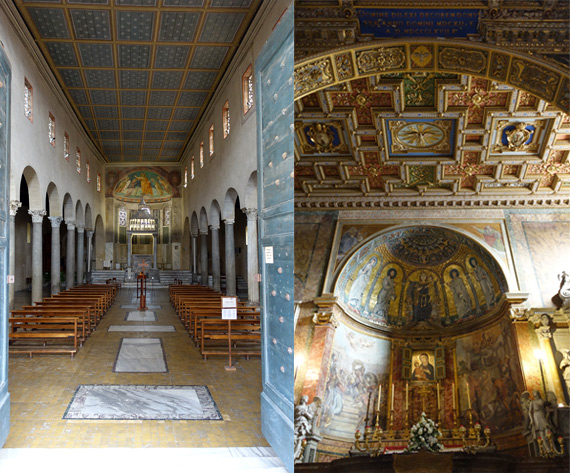
The left one is San Giorgio in Velabro. The name harks back to the ancient Roman name for this area, the Velabrum. For decades, guidebooks have said this was a marsh, as mine does, but recent coring across the neighborhood indicates that it never was a marsh or a tributary of the Tiber or a boat basin (among the comments you may read/hear). The church dates back to the 9th C, and I love that the grey granite? columns run out toward the rear on the right, and different columns are substituted (only one in photo); indeed this part of the floor is also higher, suggesting it was an earlier structure incorporated into the church. The entry around the doors had to be rebuilt after a Mafia bombing (why here?) in 1993 caused considerable damage. The rest of the church was restored in the 20th C. The ceiling is obviously a substitute. The painting over the altar is simple, yet brilliantly colored. Since we didn’t plan on visiting this church, I only discovered later that we could have peeked into a niche and seen the skull of St. George, who is famous for dragon-killing.
The church on the right is Santa Maria Nova. The city is overrun with Marian churches (honoring Mother Mary), with very few names mentioning Jesus. He dominates altar-paintings, of course….
This church is on top of a small rise that must have been taller before the valley gathered sediment (8–10 METERS in the Forum area, more that happened after abandonment, and has been removed to reveal the ruins we see today) and perhaps it was borrowed a bit. The ancient Romans named all hills, valleys, and parts of hills around their city, as well as neighborhoods. This low hill in the valley was the Velia. The only access is from the Colosseum along an old section of Roman road, and indeed we walked uphill.
An earlier Santa Maria church in the Forum was relocated here in the mid-800s, making this the new St. Mary’s. The Madonna and Child painting with the shutters that to me is the visual focal point of the apse, is of the Glykophilousa type, a “sweet love” image of the duo, with the Madonna embracing the Christ child, and the child stroking the mother’s face. It dates to the 6th C. I found the bright colors on the ceiling dramatic, set off by a maize of white-and-gold borders. Again, without the guidebook, we didn’t know to look behind grills in the south wall at paving stones described as being from the Via Sacra (road into the Forum from the east), and bearing the imprint of the knees of St. Peter, praying for the punishment of Simon Magnus, who was flying about. We also didn’t know to check out the crypt, including a Bernini.
Serendipity only floats you along so far.

We toured the Case Romane museum, which is a maze of ruins beneath the Basilica Santi Giovanni e Paolo al Celio. It is named for two brothers, martyred under the last non-Christian Roman Emperor, Julian, in 362. I have studied the map of the rooms we walked through, and it just felt like strange little spaces, with doorways leading from one to another. I was further discombobulated because the floor and ceiling elevations were up and down, and at most three rooms in a row had floors on the same level, and perhaps that consistency was introduced to make them accessible parts of the museum. Some ruins date to ancient Roman times, but part were the rooms of early Christians, late 3rd C, and into the 4th C. As near as I can tell that’s a goat and a camel near the corner, hanging from a rope to the torso, and with no hind legs. Haven’t a clue what this imagery meant to the occupants of this space.
Other activities today: we walked the length of the Circus Maximus (gigantic), and looked at archaeology in action at the SE end (the turn); I even saw a trowel! We saw cats at the Largo Torre Argentina (everyone does; they live there). We noticed little lizards in the park. We saw napping men on benches in the Piazza San Marco (noticed in other parks, too). We enjoyed the decrepit nature of the fenced-off Arch of Janus, which is really not an arch per se, but a squarish four-arched triumphal monument—only now its only triumph is that it still stands.
Posted at 3:44 PM |
1 Comment »
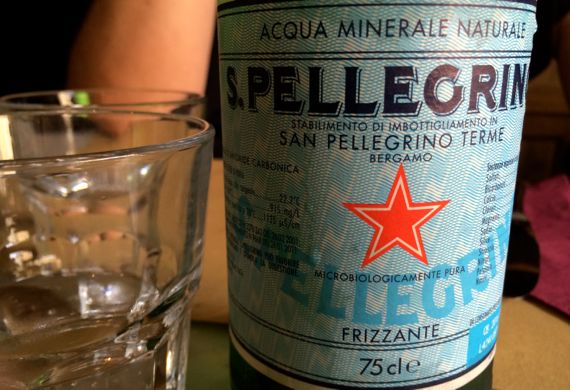
We’re in a phase of ordering frizzante, bottled mineral water with bubbles, with our meals. It’s not always Pellegrino, but I have noticed that two times the bottle held 92, and today’s restaurant served us a 75. (I think the units are decilitres/deciliters.)
Haha, we probably even paid more for the 75.
And umph years ago, all the restaurants would have been serving full liter bottles!
Posted at 2:43 PM |
Comments Off on Details, details
































